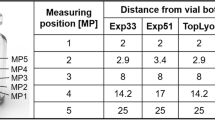Abstract
The occurrence of glass delamination is a serious concern for parenteral drug products. Over the past several years, there has been a series of product recalls involving glass delamination in parenteral drugs stored in vials which has led to heightened industry and regulatory scrutiny. In this study, a two-pronged approach was employed to assess the inner surface durability of vials and pre-filled syringes. Non-siliconized syringes were used in order to directly compare glass to glass performance between vials and syringes. The vial and syringe performance was screened with pharmaceutically relevant formulation conditions. The influence of pH, buffer type, ionic strength, and glass type and source was evaluated. In addition, an aggressive but discriminating formulation condition (glutaric acid, pH 11) was used to ascertain the impact of syringe processing. Advanced analytical tools including inductively coupled plasma/mass spectrometry, scanning electron microscopy, atomic force microscopy, and dynamic secondary ion mass spectroscopy showed significant differences in glass performance between vials and syringes. Pre-filled syringes outperform vials for most tests and conditions. The manufacturing conditions for vials lead to glass defects, not found in pre-filled syringes, which result in a less chemically resistant surface. The screening methodology presented in this work can be applied to assess suitability of primary containers for specific drug applications.









Similar content being viewed by others
References
Iacocca RG, Allgeier M. Corrosive attack of glass by a pharmaceutical compound. J Mater Sci. 2007;42(3):801–11.
Ennis RD, Pritchard R, Nakamura C, Coulon M, Yang TY, Visor GC, et al. Glass vials for small volume parenterals: influence of drug and manufacturing processes on glass delamination. Pharm Dev Technol. 2001;6(3):393–405.
FDA. Advisory to drug manufacturers: formation of glass lamellae in certain injectable drugs. 2011. http://www.fda.gov/Drugs/DrugSafety/ucm248490.htm. Accessed 05 Nov 2013.
Gin S, Godon N, Mestre JP, Vernaz EY. Experimental investigation of aqueous corrosion of R7T7 nuclear glass at 90°C in the presence of organic species. Appl Geochem. 1994;9(3):255–69.
Fearn S, McPhail DS, Oakley V. Room temperature corrosion of museum glass: an investigation using low-energy SIMS. Appl Surf Sci. 2004;231–232:510–4.
Guadagnino E, Zuccato D. Delamination propensity of pharmaceutical glass containers by accelerated testing with different extraction media. PDA J Pharm Sci Technol. 2012;66(2):116–25.
Iacocca RG, Toltl N, Allgeier M, Bustard B, Dong X, Foubert M, et al. Factors affecting the chemical durability of glass used in the pharmaceutical industry. AAPS PharmSciTech. 2010;11(3):1340–9.
Sloey C, Gleason C, Philips J. Determining the delamination propensity of pharmaceutical glass vials using a direct stress method. PDA J Pharm Sci Tech. 2013;67(1):35–42.
Jiang G, Goss M, Li G, Jing W, Shen H, Fujimori K, et al. Novel mechanism of glass delamination in Type 1A borosilicate vials containing frozen protein formulations. PDA J Pharm Sci Tech. 2013;67(4):323–35.
Badkar A, Wolf A, Bohack L, Kolhe P. Development of biotechnology products in pre-filled syringes: technical considerations and approaches. AAPS PharmSciTech. 2011;12(2):564–72.
Greystone. Prefilled syringes to 2018—devices, drugs, markets, players and prospects. 2013.
USP 35 < 660 > Containers—glass for surface glass test https://mc.usp.org/sites/default/files/documents/GeneralChapterPDFs/660ContainersGlass.pdf. Accessed 05 Nov 2013.
Ramkumar J, Chandramouleeswaran S, Sudarsan V, Vatsa RK, Shobha S, Shrikhande VK, et al. Boroaluminosilicate glasses as ion exchange materials. J Non-Cryst Solids. 2010;50–51:2813–9.
Rafatullah M, Sulaiman O, Hashim RAA. Adsorption of methylene blue on low-cost adsorbents: a review. J Hazard Mater. 2010;177:70–80.
Cailleteau C, Angeli F, Devreux F, Gin S, Jestin J, Jollivet P, et al. Insight into silicate-glass corrosion mechanisms. Nat Mater. 2008;7:978–83.
Zhao M, Tang Z, Liu P. Removal of methylene blue from aqueous solution with silica nano-sheets derived from vermiculite. J Hazard Mater. 2008;158(1):43–51.
Chakrabarti S, Dutta BK. On the adsorption and diffusion of methylene blue in glass fibers. J Colloid Interface Sci. 2005;286(2):807–11.
Hang PT, Brindley GW. Methylene blue absorption by clay minerals—determination of surface areas and cation exchange capacities (clay—organic studies XVIII). Clays Clay Minerals. 1970;18(4):203–12.
Ghosh D, Bhattacharyya KG. Adsorption of methylene blue on kaolinite. Appl Clay Sci. 2002;20(6):295–300.
Bacon FR, Raggon FC. Promotion of attack on glass and silica by citrate and other anions in neutral solutions. J Am Ceram Soc. 1959;42(4):199–205.
Ledieu A, Devreux F, Barboux P, Sicard L, Spallac O. Leaching of borosilicate glasses. I. experiments. J Non-Cryst Solids. 2004;343:3–12.
Borchert SJ, Ryan MM, Davison RL, Speed W. Accelerated extractable studies of borosilicate glass containers. J Parenter Sci Technol. 1989;43(2):67–79.
Ebert WL. The effects of the glass surface area/solution volume ratio on glass corrosion: a critical review. National Technical Information Service; 1995.
Ogawa T, Miyajima M, Wakiyama NKT. Effects of phosphate buffer in parenteral drugs on particle formation from glass vials. Chem Pharm Bull. 2013;61(5):539–45.
Geisler T, Janssen A, Scheiter D, Stephan T, Berndt J, Putnis A. Aqueous corrosion of borosilicate glass under acidic conditions: a new corrosion mechanism. J Non-Cryst Solids. 2010;356(28–30):1458–65.
Shelby JE. Introduction to glass science and technology, 2nd ed. Royal Society of Chemistry; 2005.
Varshneya AK. Fundamentals of inorganic glasses. Academic Press; 1994.
Acknowledgments
The authors gratefully acknowledge the support and effort of the following people: Changyun Xiong, Feng Zhang, Richard Evans, and Harry Sugg.
Author information
Authors and Affiliations
Corresponding author
Rights and permissions
About this article
Cite this article
Zhao, J., Lavalley, V., Mangiagalli, P. et al. Glass Delamination: a Comparison of the Inner Surface Performance of Vials and Pre-filled Syringes. AAPS PharmSciTech 15, 1398–1409 (2014). https://doi.org/10.1208/s12249-014-0167-y
Received:
Accepted:
Published:
Issue Date:
DOI: https://doi.org/10.1208/s12249-014-0167-y



